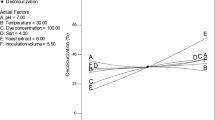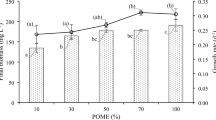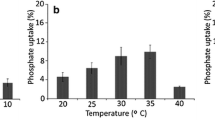Abstract
The conventional treatment process of palm oil mill effluent (POME) produces a highly colored effluent. Colored compounds in POME cause reduction in photosynthetic activities, produce carcinogenic by-products in drinking water, chelate with metal ions, and are toxic to aquatic biota. Thus, failure of conventional treatment methods to decolorize POME has become an important problem to be addressed as color has emerged as a critical water quality parameter for many countries such as Malaysia. Aspergillus fumigatus isolated from POME sludge was successfully grown in POME supplemented with glucose. Statistical optimization studies were conducted to evaluate the effects of the types and concentrations of carbon and nitrogen sources, pH, temperature, and size of the inoculum. Characterization of the fungus was performed using scanning electron microscopy, Fourier transform infrared (FTIR) spectroscopy, and Brunauer, Emmet, and Teller surface area analysis. Optimum conditions using response surface methods at pH 5.7, 35 °C, and 0.57 % w/v glucose with 2.5 % v/v inoculum size resulted in a successful removal of 71 % of the color (initial ADMI of 3,260); chemical oxygen demand, 71 %; ammoniacal nitrogen, 35 %; total polyphenolic compounds, 50 %; and lignin, 54 % after 5 days of treatment. The decolorization process was contributed mainly by biosorption involving pseudo-first-order kinetics. FTIR analysis revealed that the presence of hydroxyl, C–H alkane, amide carbonyl, nitro, and amine groups could combine intensively with the colored compounds in POME. This is the first reported work on the application of A. fumigatus for the decolorization of POME. The present investigation suggested that growing cultures of A. fumigatus has potential applications for the decolorization of POME through the biosorption and biodegradation processes.







Similar content being viewed by others
References
Abdullah N, Ujang Z, Yahya A (2011) Aerobic granular sludge formation for high strength agro-based wastewater treatment. Bioresour Technol 102(12):6778–6781
Agustin M, Sengpracha W, Phutdhawong W (2008) Electrocoagulation of palm oil mill effluent. Int J Environ Res Public Health 5(3):177–180
Akar ST, Gorgulu A, Kaynak Z, Anilan B, Akar T (2009) Biosorption of Reactive Blue 49 dye under batch and continuous mode using a mixed biosorbent of macro-fungus Agaricus bisporus and Thuja orientalis cones. Chem Eng J 148(1):26–34
Aksu Z, KarabayIr G (2008) Comparison of biosorption properties of different kinds of fungi for the removal of Gryfalan Black RL metal-complex dye. Bioresour Technol 99(16):7730–7741
Bayramoğlu G, Yakup Arıca M (2007) Biosorption of benzidine based textile dyes “Direct Blue 1 and Direct Red 128” using native and heat-treated biomass of Trametes versicolor. J Hazard Mater 143(1–2):135–143
Belgacem MN, Gandini A (2008) Monomers, polymers and composites from renewable resources. Elsevier, Amsterdam
Chidi SB, Godana B, Ncube I, Rensburg EJV, Cronshaw A, Abotasi EK (2008) Production, purification and characterization of celullase-free xylanase from Aspergillus terreus UL 4209. Afr J Biotechnol 7(21):3939–3948
Chowdhury S, Chakraborty S, Saha P (2012) Response surface optimization of a dynamic dye adsorption process: a case study of crystal violet adsorption onto NaOH-modified rice husk. Environ Sci Pollut Res Int. doi:10.1007/s11356-012-0989-7
DOE (1999) Industrial processes and the environment (handbook no. 3): crude palm oil industry. Department of Environment Malaysia, Kuala Lumpur
Du L-N, Yang Y-Y, Li G, Wang S, Jia X-M, Zhao Y-H (2010) Optimization of heavy metal-containing dye Acid Black 172 decolorization by Pseudomonas sp. DY1 using statistical designs. Int Biodeter Biodegr 64(7):566–573
Erum S, Ahmed S (2011) Comparison of dye decolorization efficiencies of indigenous fungal isolates. Afr J Biotechnol 10(17):3399–3411
Fu Y, Viraraghavan T (2003) Column studies for biosorption of dyes from aqueous solutions on immobilised Aspergillus niger fungal biomass. Water SA 29(4):465–472
Gupta VK, Rastogi A (2008a) Biosorption of lead from aqueous solutions by green algae Spirogyra species: kinetics and equilibrium studies. J Hazard Mater 152(1):407–414
Gupta VK, Rastogi A (2008b) Biosorption of lead(II) from aqueous solutions by non-living algal biomass Oedogonium sp. and Nostoc sp.—a comparative study. Colloids Surf B Biointerfaces 64(2):170–178
Gupta VK, Rastogi A (2008c) Equilibrium and kinetic modelling of cadmium(II) biosorption by nonliving algal biomass Oedogonium sp. from aqueous phase. J Hazard Mater 153(1–2):759–766
Gupta VK, Rastogi A (2008d) Sorption and desorption studies of chromium(VI) from nonviable cyanobacterium Nostoc muscorum biomass. J Hazard Mater 154(1–3):347–354
Gupta VK, Rastogi A (2009) Biosorption of hexavalent chromium by raw and acid-treated green alga Oedogonium hatei from aqueous solutions. J Hazard Mater 163(1):396–402
Gupta VK, Shrivastava AK, Jain N (2001) Biosorption of chromium(VI) from aqueous solutions by green algae Spirogyra species. Water Res 35(17):4079–4085
Gupta VK, Mittal A, Gajbe V, Mittal J (2006a) Removal and recovery of the hazardous azo dye acid orange 7 through adsorption over waste materials: bottom ash and de-oiled soya. Ind Eng Chem Res 45(4):1446–1453. doi:10.1021/ie051111f
Gupta VK, Mittal A, Kurup L, Mittal J (2006b) Adsorption of a hazardous dye, erythrosine, over hen feathers. J Colloid Interface Sci 304(1):52–57
Gupta VK, Rastogi A, Saini VK, Jain N (2006c) Biosorption of copper(II) from aqueous solutions by Spirogyra species. J Colloid Interface Sci 296(1):59–63
Gupta VK, Ali I, Saini VK (2007a) Adsorption studies on the removal of Vertigo Blue 49 and Orange DNA13 from aqueous solutions using carbon slurry developed from a waste material. J Colloid Interface Sci 315(1):87–93
Gupta VK, Ali I, Saini VK (2007b) Defluoridation of wastewaters using waste carbon slurry. Water Res 41(15):3307–3316
Gupta VK, Jain R, Varshney S (2007c) Removal of Reactofix golden yellow 3 RFN from aqueous solution using wheat husk—an agricultural waste. J Hazard Mater 142(1–2):443–448
Gupta VK, Carrott PJM, Carrott MMLR, Suhas (2009) Low-cost adsorbents: growing approach to wastewater treatment—a review. Crit Rev Environ Sci Tech 39(10):783–842
Gupta VK, Rastogi A, Nayak A (2010) Adsorption studies on the removal of hexavalent chromium from aqueous solution using a low cost fertilizer industry waste material. J Colloid Interface Sci 342(1):135–141
Ho YS, McKay G (1998) Sorption of dye from aqueous solution by peat. Chem Eng J 70:115–124
Holt P, Barton G, Mitchell C (1999) Electrocoagulation as a wastewater treatment. Paper presented at the Third Annual Australian Environmental Engineering Research Event, Castlemaine, Victoria, November, pp 23–26
Jamal P, Alam MZ, Mohamad AB (2007) Microbial bioconversion of palm oil mill effluent to citric acid with optimum process conditions. In: 3rd Kuala Lumpur International Conference on Biomedical Engineering 2006, pp 483–487
** X-C, Liu G-Q, Xu Z-H, Tao W-Y (2007) Decolorization of a dye industry effluent by Aspergillus fumigatus XC6. Appl Microbiol Biotechnol 74(1):239–243. doi:10.1007/s00253-006-0658-1
Kindsigo M, Kallas J (2009) Wet oxidation of debarking water: changes in lignin content and biodegradability. Environ Chem Lett 7(2):121–126. doi:10.1007/s10311-008-0144-3
Korabecna M (2007) The variability in the fungal ribosomal DNA (ITS1, ITS2, and 5.8S rRNA gene): its biological meaning and application in medical mycology. In: Mendez-Vilas A (ed) Communicating current research and educational topics and trends in applied microbiology. Formatex, Spain, pp 783–787
Kushairi A, Parveez GKA (2009) Development of value-added products in oil palm via genetic modification and non-genetic modification routes. In: Accelerating Commercialization in Biotechnology, Kuala Lumpur Convention Centre
Lagergren S (1898) About the theory of so-called adsorption of soluble substances. Kungliga Svenska Vetenskapsakademiens Handlingar 24(4):1–39
Lim CK, Bay HH, Kee TC, Majid ZA, Ibrahim Z (2011) Decolourisation of reactive black 5 using Paenibacillus sp. immobilised onto macrocomposite. J Bioremed Biodegrad S1:004. doi:10.4172/2155-6199.S1-004
Limkhuansuwan V, Chaiprasert P (2010) Decolorization of molasses melanoidins and palm oil mill effluent phenolic compounds by fermentative lactic acid bacteria. J Environ Sci 22(8):1209–1217
Y-g L, Fan T, G-m Z, Li X, Tong Q, Ye F, Zhou M, W-h X, Y-e H (2006) Removal of cadmium and zinc ions from aqueous solution by living Aspergillus niger. Trans Nonferrous Met Soc China 16(3):681–686
Mohammad P, Azarmidokht H, Fatollah M, Mahboubeh B (2006) Application of response surface methodology for optimization of important parameters in decolorizing treated distillery wastewater using Aspergillus fumigatus UB2 60. Int Biodeter Biodegr 57(4):195–199
Mohan SV, Karthikeyan J (1997) Removal of lignin and tannin colour from aqueous solution by adsorption onto activated charcoal. Environ Pollut 97(1–2):183–187
Murugesan K, Dhamija A, Nam I-H, Kim Y-M, Chang Y-S (2007) Decolourization of reactive black 5 by laccase: optimization by response surface methodology. Dyes Pigments 75(1):176–184
Oswal N, Sarma PM, Zinjarde SS, Pant A (2002) Palm oil mill effluent treatment by a tropical marine yeast. Bioresour Technol 85(1):35–37
Patel R, Suresh S (2008) Kinetic and equilibrium studies on the biosorption of reactive black 5 dye by Aspergillus foetidus. Bioresour Technol 99(1):51–58
Paul ML, Samuel J, Chandrasekaran N, Mukherjee A (2012) Comparative kinetics, equilibrium, thermodynamic and mechanistic studies on biosorption of hexavalent chromium by live and heat killed biomass of Acinetobacter junii VITSUKMW2, an indigenous chromite mine isolate. Chem Eng J 187:104–113
Pearl IA, Benson HK (1990) The determination of lignin in sulphide pul**. PapTrade J 111(18):35–36
Pillai MC, Blethrow H, Higashi RM, Vines CA, Cherr GN (1997) Inhibition of the sea urchin sperm acrosome reaction by a lignin-derived macromolecule. Aquat Toxicol 37(2–3):139–156
Raja Ehsan Shah RSS, Kaka Singh PK (2004) Treatment of palm oil mill effluent (POME) using membrane technology. In: Regional Symposium on Membrane Science and Technology, Puteri Pan Pacific Hotel, Johor Bharu
Sharma P, Singh L, Dilbaghi N (2009) Optimization of process variables for decolorization of Disperse Yellow 211 by Bacillus subtilis using Box-Behnken design. J Hazard Mater 164(2–3):1024–1029
Singleton VL, Orthofer R, Lamuela-Raventós RM (1999) Analysis of total phenols and other oxidation substrates and antioxidants by means of Folin–Ciocalteu reagent. In: Lester P (ed) Methods in enzymology, vol. 299. Academic, San Diego, pp 152–178
Sulaiman N, Ling CK (2004) Membrane ultrafiltration of treated palm oil mill effluent (POME). J Teknol 41:113–120
Volesky B (2007) Biosorption and me. Water Res 41(18):4017–4029
Vukovic M, Domanovac T, Briki F (2008) Removal of humic substances by biosorption. J Environ Sci 20(12):1423–1428
Wang B-E, Hu Y-Y (2008) Bioaccumulation versus adsorption of reactive dye by immobilized growing Aspergillus fumigatus beads. J Hazard Mater 157(1):1–7
Wang J-P, Chen Y-Z, Wang Y, Yuan S-J, Yu H-Q (2011) Optimization of the coagulation-flocculation process for pulp mill wastewater treatment using a combination of uniform design and response surface methodology. Water Res 45(17):5633–5640
Wong YC, Szeto YS, Cheung WH, McKay G (2004) Pseudo-first-order kinetic studies of the sorption of acid dyes onto chitosan. J Appl Polymer Sci 92(3):1633–1645. doi:10.1002/app.13714
**n B, Chen G, Zheng W (2010) Bioaccumulation of Cu-complex reactive dye by growing pellets of Penicillium oxalicum and its mechanism. Water Res 44(12):3565–3572
**n B, **a Y, Zhang Y, Aslam H, Liu C, Chen S (2012) A feasible method for growing fungal pellets in a column reactor inoculated with mycelium fragments and their application for dye bioaccumulation from aqueous solution. Bioresour Technol 105:100–105
Zahrim AY, Rachel FM, Menaka S, Su SY, Melvin F, Chan ES (2009) Decolorisation of anaerobic palm oil mill effluent via activated sludge-granular activated carbon. World Appl Sci J 5:126–129, Special Issue for Environment
Zhou JL (1992) Biosorption and desorption of humic acid by microbial biomass. Chemosphere 24(11):1573–1589
Zhou JL, Banks CJ (1993) Mechanism of humic acid colour removal from natural waters by fungal biomass biosorption. Chemosphere 27(4):607–620
Acknowledgments
The authors would like to express their appreciation to the Ministry of Sciences and Innovation Malaysia (National Science Fellowship) and Universiti Teknologi Malaysia for the financial support. The authors also would like to thank the local company Johor for sampling of the wastewater.
Author information
Authors and Affiliations
Corresponding author
Additional information
Responsible editor: Vinod Kumar Gupta
Rights and permissions
About this article
Cite this article
Neoh, C.H., Yahya, A., Adnan, R. et al. Optimization of decolorization of palm oil mill effluent (POME) by growing cultures of Aspergillus fumigatus using response surface methodology. Environ Sci Pollut Res 20, 2912–2923 (2013). https://doi.org/10.1007/s11356-012-1193-5
Received:
Accepted:
Published:
Issue Date:
DOI: https://doi.org/10.1007/s11356-012-1193-5




